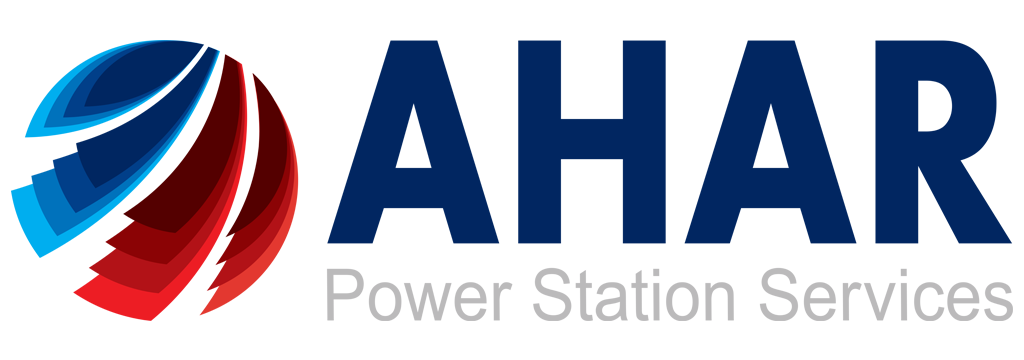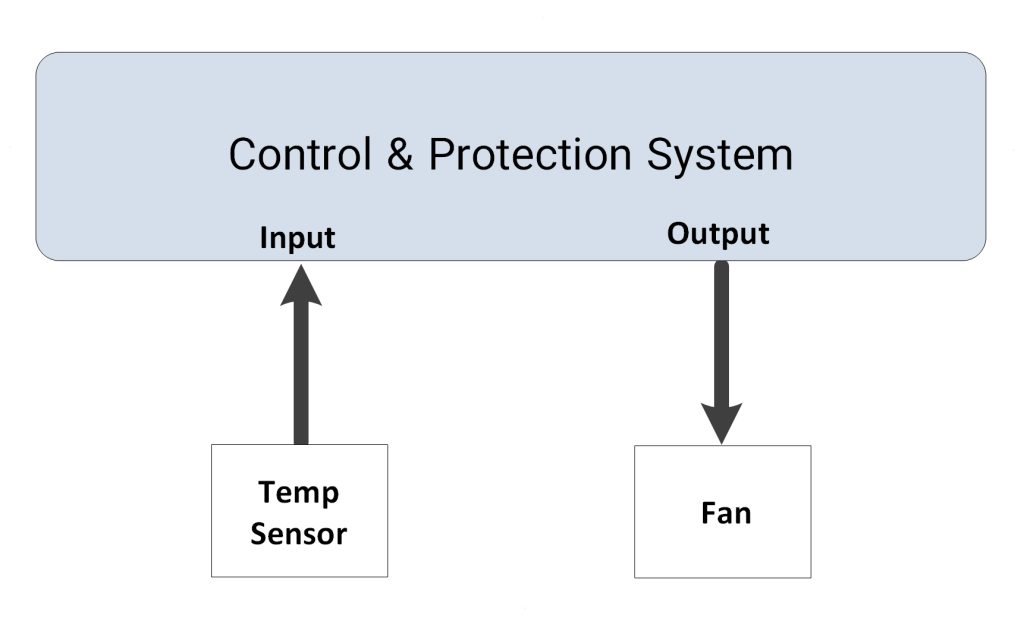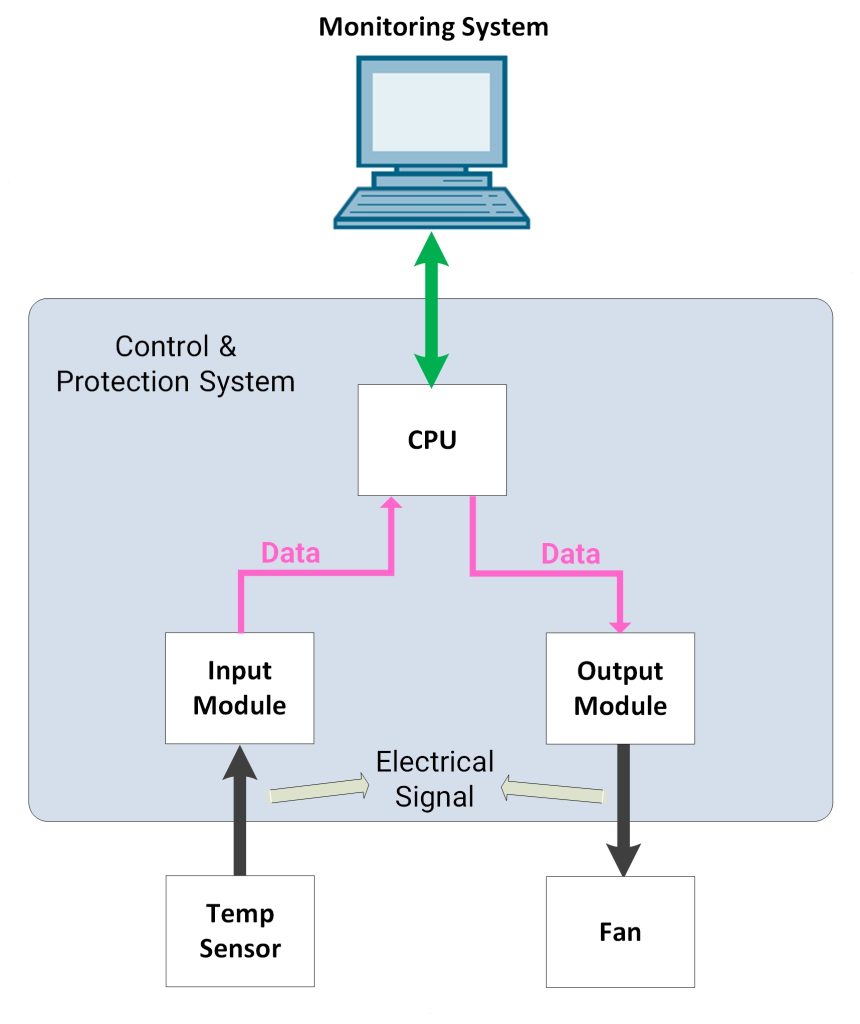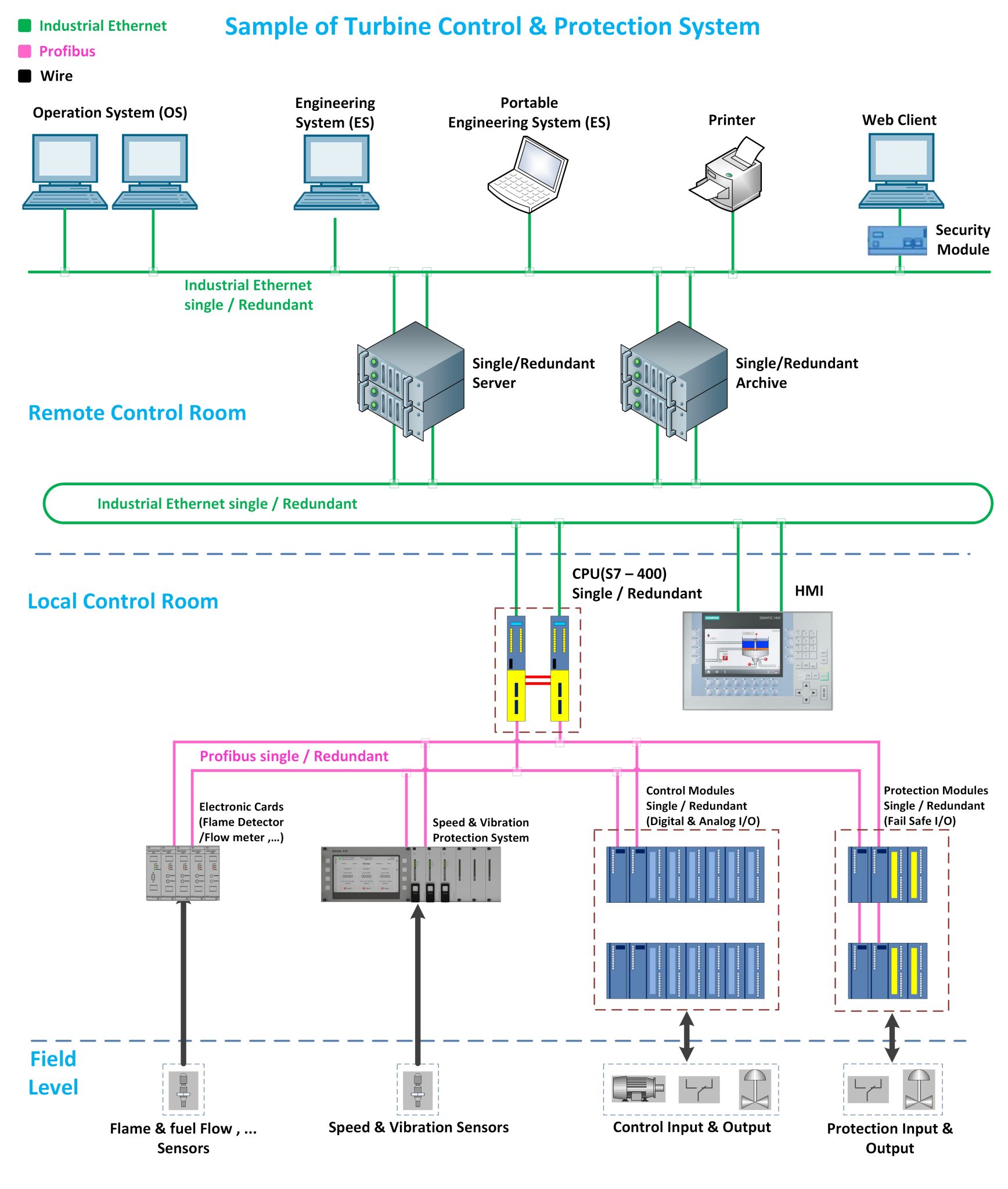Turbine Control System
In order to control the working steps of turbines and also protect them against mechanical and electrical faults, a turbine control and protection system is required.
In this article, we will first get acquainted with the basics of how control and protection systems work, and then we will introduce the turbine control and protection system manufactured by Ahar Company. We will also describe its components, specifications, and capabilities.

Turbine Control System
In order to control the working steps of turbines and also protect them against mechanical and electrical faults, a turbine control and protection system is required.
In this article, we will first get acquainted with the basics of how control and protection systems work, and then we will introduce the turbine control and protection system manufactured by Ahar Company. We will also describe its components, specifications, and capabilities.

Basics of Control Systems
Before we get into the specifics of turbine control and protection systems, it is important to have a basic understanding of the general structure and equipment of control and protection systems that are used in a variety of systems, such as turbine control, automotive, petrochemical, and so on.
How a Control System Works with a Simple Example
To explain a control system, let’s start with a simple example. Suppose you want a fan to turn on and cool the air if the temperature in a room rises above a certain level. To do this, you need a processing unit that reads the temperature, compares it to your desired temperature, and turns on the fan if it exceeds it.
The following figure shows the general structure for the example we just gave.
All of the equipment that sends the temperature value to the processor, the processor itself, the part that commands the fan, and also the instructions that you have put in the processor, are all called a control system.
Now let’s explain this simple control system in more detail. Look at the figure below. This is the same simple control system from before, but some of the important equipment is shown in more detail in the figure below.
As shown in the above figure, since the temperature value measured by the sensor is electrical (voltage or current), in order to process this information by the processor, it is necessary to use equipment called input and output modules.
Input/output modules are used to convert the electrical signals from the sensors to digital data that the processor can understand. They also convert the digital control signals from the processor to electrical signals that can be used to control the actuators.
It can also be seen that a monitoring system is connected to the processor. with this system, an engineer can download the instructions related to the desired behavior of the control system into the processor. In addition, by designing user interfaces, it is possible to see the current temperature of the room, the on/off status of the fan, and also change the temperature at which the fan should turn on.
What happens in larger control systems?
Here are some of the things that are done in larger control systems:
- Data acquisition: Sensors collect data from the process, such as temperature, pressure, and flow rate. This data is then transmitted to the control system.
- Signal processing: The control system processes the data to extract useful information, such as the current state of the process and any deviations from the desired state.
- Control algorithm: The control system uses a control algorithm to calculate the desired control actions. The control algorithm takes into account the current state of the process, the desired state of the process, and any disturbances.
- Control output: The control system sends control signals to the actuators, which then manipulate the process to achieve the desired state.
- Monitoring: The control system monitors the process to ensure that it is operating as desired. This includes monitoring the process variables, the control outputs, and the performance of the control system.
Some of the challenges of large control systems include: - Complexity: Large control systems can be very complex, with many components and interactions. This can make it difficult to design, implement, and maintain these systems.
- Reliability: Large control systems must be highly reliable, as they are often used in critical applications. This can be a challenge, as there are many potential points of failure in these systems.
- Security: Large control systems can be vulnerable to cyberattacks. This is a growing concern, as the number of cyberattacks on critical infrastructure is increasing.
Why are control systems called "control and protection" systems?
In practice, control systems control the process in normal conditions. However, if a dangerous condition occurs, such as a fire or a malfunctioning equipment, information is sent to the system for processing by the relevant sensors, such as a fire sensor or a pressure sensor. The processor then decides to stop the process to prevent damage.
Therefore, the control system actually has the task of protection as well, which is why it is called a control and protection system.
Of course, due to the importance of the protection section, special equipment is used to implement it.
Functions of Turbine Control and Protection Systems
In this article, you have become familiar with different types of turbines and how they work. Here, we want to discuss how to control a turbine and also how to protect it in dangerous conditions. To do this, we need to be familiar with the performance and functions of turbine control and protection systems.
Functions of the Turbine Control and Protection System with a Simple Example
In this figure, you can see a simple example of gas turbine control and protection.
One of the parameters that must be controlled in the turbine is its speed, which must be kept constant at a specific value.
On the other hand, if the turbine speed exceeds a certain limit (for example, due to a stuck fuel valve), the turbine must be stopped quickly.
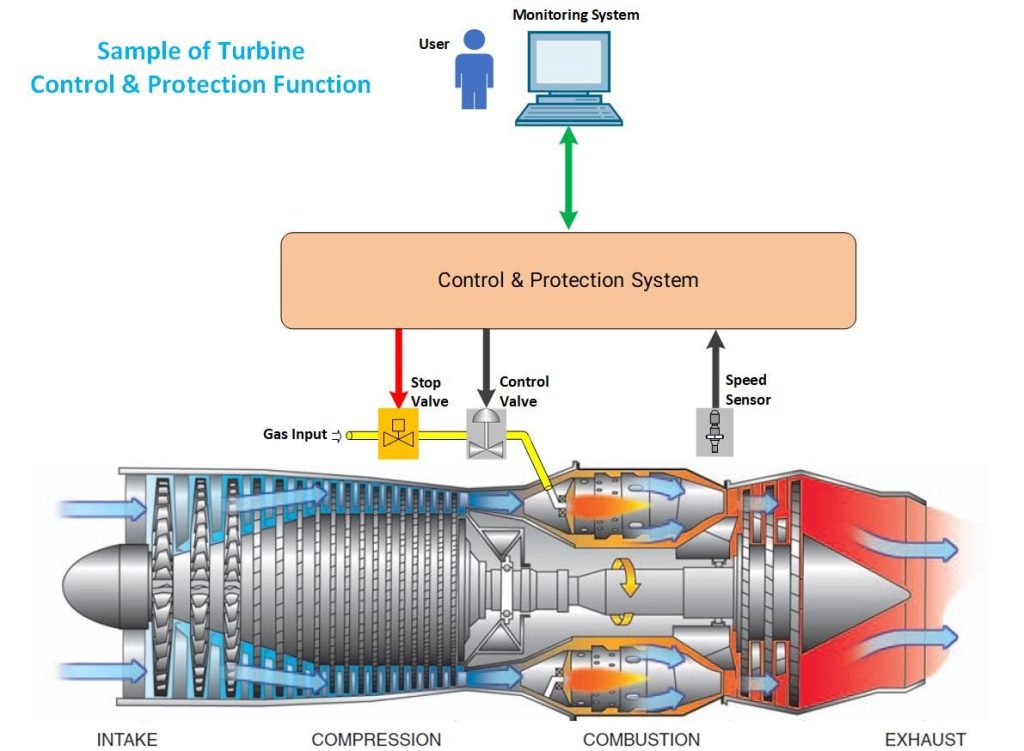
First, let’s get acquainted with the actuators and sensors in the above figure.
They are:
- Speed Sensor: Its function is to read the turbine speed value and send it to the processor.
- STOP Valve: Its function is to open the fuel path to the turbine under normal operating conditions and close it under shutdown and protection conditions. This valve is of the On/Off type and does not have the ability to control fuel flow.
- Control Valve: The function of this valve is to control the fuel flow. This valve is of the linear type, which means that it can be opened from 0 to 100% to the desired value to allow the desired flow to pass through it. In fact, by decreasing or increasing the fuel flow, the turbine speed can be decreased or increased to reach the desired speed.
Now let’s see how the control and protection system uses the equipment we introduced to control and protect the turbine speed.
In the above figure, we assume that the turbine is rotating and there is a flame, but the turbine speed needs to be increased to reach the set value.
The speed sensor reads the turbine speed and sends it to the control and protection system. The speed is then processed there. If the processor finds the turbine speed to be lower than the set value, it commands the fuel valve (Control Valve) to open wider to allow more gas to enter the turbine. This will increase the turbine speed and bring it to the desired value.
In a turbine, the load on the turbine can vary at any time, which means that its speed can also vary. Therefore, the control system continuously adjusts the amount of fuel to keep the turbine speed at the specified value.
Now, if for any reason the speed increases beyond the permissible limit (for example, due to a stuck Control Valve), the protection system commands the stop valve to close and cut off the inlet gas to protect the turbine from overspeed.
The built-in monitoring system can also display the speed value to the user and allows the user to set the desired speed for control.
Introduction to the Functions of a Comprehensive Turbine Control and Protection System
In the previous section, we introduced a simple turbine control and protection system. However, in control and protection systems, other parameters such as exhaust temperature, turbine acceleration, and auxiliary equipment such as the cooling and lubrication system are also controlled and protected. Some of these are mentioned below:
Functions performed by the turbine control system:
• Speed control
• Acceleration control
• Temperature control
• Control of auxiliary equipment such as lubrication and cooling
• Shutdown control
• …
Functions performed by the protection system:
• Over-speed protection
• Over-temperature protection
• Over-vibration protection
• Protection against inadequate lubrication pressure and temperature
• Fire protection
• …
Functions performed by the monitoring system:
• Ability to command turbine start and stop
• Ability to adjust control and protection parameters (such as desired speed)
• Viewing the status of turbine parameters such as temperature, speed, pump on/off
• Recording alarms and past values for engineering analysis of problems
Introduction to Ahar Control and Protection System
Ahar Company is a manufacturer of turbine control and protection systems. In this article, we will explain the structure and specifications of this system. First, we will briefly explain the different types of control systems available in the world and then we will specify the structure that Ahar Company has used for its turbine control and protection projects.
Brief Introduction to Control and Protection Systems Manufactured by Different Companies
Control and protection equipment are generally manufactured by several companies, and engineering companies use them according to their expertise to control their desired process, for example in a steel mill, refinery, petrochemical plant, car manufacturing plant, turbine, or …
In fact, engineering companies procure the necessary equipment for control and protection according to their needs, create their hardware structure, and implement the relevant process through coding.
Control and protection systems are known as DCS (Distributed Control System), and the manufacturers of this equipment build their own DCS according to their own approach.
Some of the companies that manufacture DCS include:
- Siemens
- Yokogawa
- ABB
- …
The general structure of all DCS is the same. They all read, process, and issue control and protection commands for the parameters of the equipment in question. They also all have monitoring and storage systems.
However, they may differ in the following:
- Processor speed
- The amount of code that can be implemented
- Programming language
- Network protocols
- Graphics in monitoring systems
- Type of input and output ports
- Number of inputs and outputs that can be implemented
- …

The DCS System Selected by Ahar Company
Ahar has selected the PCS7 DCS system from Siemens for its turbine control and protection system.
PCS7 is a well-known DCS system with many capabilities for controlling and protecting complex processes.
The following are some of the key features of PCS7:
- A modular design that allows it to be scaled to meet the needs of different projects
- A wide range of hardware and software components that can be used to create a customized control system
- A powerful programming language that allows users to create complex control algorithms
- A comprehensive suite of tools for monitoring and managing the control system
PCS7 is a popular choice for turbine control and protection systems because it offers a high level of performance, reliability, and security.
The following are some of the benefits of using PCS7 for turbine control and protection:
- Improved turbine performance and efficiency
- Reduced emissions
- Increased safety and reliability
- Reduced maintenance costs
Ahar has a long history of using Siemens DCS systems for its turbine control and protection projects. The company has a team of experienced engineers who are experts in the design, installation, and commissioning of PCS7 systems. Ahar is confident that the use of PCS7 will help it to provide its customers with the best possible turbine control and protection solutions.
The figure below shows the general structure of Siemens PCS7. This combination includes different modes, some of which are used depending on the needs of each project.
As mentioned and as shown in the figure above, Siemens DCS has various combinations and conditions. Ahar Company implements part of this DCS for turbine control and protection according to the needs of each project.
In fact, the company implements control and protection panels and codes the relevant functions based on the control and protection processes of each turbine. Finally, it starts up and tests them.
The name of the company’s product that is used for turbine control and protection is “Ramyar”. In the rest of this article, we will get acquainted with the hardware combination used in it, as well as its software and monitoring capabilities, etc.
Explanation of a Simple Configuration for a Turbine Control and Protection System
In this section of the report, we will explain a control and protection system implemented by Ahar Company.
Of course, for a better understanding, we will start with a system with minimal features and explain more equipment and features in the next sections of the article.
The figure below shows a simple configuration for a turbine control and protection system, which we will explain in more detail below.
In the above figure, input and output equipment are generally wired from the Field Level section to the control and protection system. These equipment are the same speed, vibration, pressure sensors and actuators such as fuel valves, lubrication pumps, etc.
At the next stage, the sensors and actuators are connected to the input and output ports (modules). Then, the information related to each sensor is connected to the processor (CPU) by a Profibus cable. In the processor, the information of each sensor is processed according to the code written by Ahar Company, and finally the processor sends the necessary command to the equipment such as fuel valve, pump, fan, etc. through the output modules.
In addition, separate modules are considered for the control and protection section signals, which we will discuss more in the next sections.
We see that in addition to the input and output modules, there are other equipment such as speed and vibration protection system and electronic interface cards. The reason is that some sensors, due to the type of electrical signal they produce, require special equipment to read and communicate with the processor, so those equipment are used, and in fact, these interface cards also play the role of the same modules.
Usually, the input and output modules and processors are placed in a panel, which is installed in the local control room (near the turbine). Now, in order to be able to start and stop the unit from there and to see the status of its different parts, a monitoring system (HMI) is considered next to the processor.
Of course, a monitoring system is also considered for monitoring in the remote control room.
In the rest of this article, each of these sections in the above control and protection system will be explained separately.
CPU
In this structure, the S7-400 processor is used, and the coding of control and protection processes is done in it. As can be seen, this processor is connected to high-level equipment such as monitoring systems via Industrial Ethernet and is connected to input and output modules via Profibus.
Control Modules
Modules of this section are used for control sections such as controlling pumps, fans, fuel valves, etc. The figure below shows this section in more detail, which will be explained in more detail below.
IM (Interface Module) modules are used to communicate between the processor and the input and output ports (Modules).
To communicate between the field equipment and the processor, logic and analog input and output modules are used. The modules are connected to the processor via Profibus and via the IM module. We have explained the tasks of these modules in more detail below:
– Digital Input Module
It is used to read logic statuses such as various pressure, level, push button transmitters, etc.
– Digital Output Module
It is used to command various equipment that have an On/Off state, such as various pumps, fans, etc.
– Analog Input Module
It is used to read analog signals such as oil pressure, compressor pressure, fuel valve opening position, etc.
– Analog Output Module
It is used to command fuel valves.
– Thermocouple/RTD Module
This module reads various temperature sensors and can be used to read, for example, exhaust temperature, oil temperature, etc.
Protection Modules
In the implemented structure, due to the importance of the protection section, special protection modules are used to read the turbine protection signals and command the turbine to stop.
The input and output modules selected for the protection signals are of the fail-safe type to provide more security for the protection information processing process. It is worth noting that fail-safe modules are modules that replace invalid data values with safe values. Some of the features of these modules are listed below:
– They have an independent processor from the protection processor.
– They have the ability to detect internal module problems and select a safe state.
– They can detect improper communication with the processor and select a safe state.
The figure below shows the protection section equipment in more detail, which will be explained in more detail below.
IM (Interface Module) modules are used to communicate between the processor and the input and output ports (Modules).
Logic input and output modules are used to communicate between the field equipment and the processor. The modules are connected to the processor via Profibus and via the IM module. We have explained the tasks of these modules in more detail below:
FailSafe Digital Input Module
It is used to read logic statuses such as various pressure, level, and push button transmitters, etc., which play a role in turbine protection.
FailSafe Digital Output Module
It is used to command the fuel Stop Valve. In fact, in normal turbine operation, this module issues the open command to the Stop Valve, and in dangerous conditions, it issues the close command to the valve to quickly stop the turbine.
Speed & Vibration Protection System
Over-speed and vibration protection are of particular importance in turbines, so a dedicated system is provided for this purpose in the turbine protection system.
This system sends information about speed and vibration, such as instantaneous speed and vibration, alarms, and the health status of the system itself, to the processor. The processor also stops the turbine to protect it if the speed and vibration exceed the permissible limit.
However, due to the high importance of protection against over-speed and vibration of the turbine, this system can stop the unit directly and without the main processor. In fact, this system can directly command the Stop Valve to close.
This system is one of Ahar Company’s products, and its specifications can be found here.
The figure below shows the Ahar speed and vibration protection system called “Rayan“.

Explanation of the details of flame detector cards, flowmeters, etc.
To convert some signals, it is necessary to install an interface card between the sensor and the processor to convert the electrical signals of the sensors to the standard signal required by the processor. For this purpose, special electronic cards are used. Some of these cards are introduced below.
• Flame Detector Cards
It is used for the presence or absence of flame in the combustion chambers. The flame detector sensor is connected to this card and the standard signal indicating the flame status is connected to the processor.
• Flowmeter Card
It is used to measure the fuel flow. In units that operate with liquid fuel such as diesel, it is necessary to know the fuel flow to control the turbine.
• LVDT Valve Feedback Cards
In some units, LVDT is used to measure the opening value of valves such as the gas fuel valve. Since the LVDT signals must be converted to standard signals for the processor, this interface card is used.
HMI Monitoring System
In the presented configuration, one HMI (Human Machine Interface) is considered on the turbine panel for monitoring and applying the required commands for operation.
This HMI has dedicated operating pages including displaying the status of the main turbine parameters such as exhaust temperature, turbine speed, vibrations, fuel path, lubrication, dedicated pages for displaying the status of the generator and excitation, displaying alarms, etc.
This equipment is selected from the highest range of Siemens multi-panels, and more information about it can be found here.
The figure below shows a sample of an HMI page implemented by this company.

Monitoring System (Operation System)
Usually in power plants, there are rooms called the central control room which are far from the turbine and the operators in those rooms monitor the units and different parts of their complex. Therefore, in the presented configuration, an Operation System (OS) monitoring system has been considered which can be installed in a location further away from the control and protection system and the turbine parameters can be observed and commands can also be issued to it.
This system is connected to the turbine control and protection panel via an industrial Ethernet network.
This system has dedicated operating pages including unit start-up and stop, turbine status display such as exhaust temperature, compressor status, vibrations, fuel path, lubrication, combustion chambers, dedicated pages for displaying generator status, active alarms, alarm archive, etc.
In the OS system, it is possible to view and archive signal trends and all unit events are archived with high accuracy and for an unlimited time. It also has the ability to simulate and apply analog and logic values to the control system.
In these systems, the access levels of management, maintenance, operation, etc. are adjustable and each person can have access to their own information. The hardware structure of these systems is considered industrial in order to have the most stable possible state.
This computer uses Siemens’ very powerful monitoring and information processing software (WINCC).
Here are some examples of OS monitoring screens designed by this company:
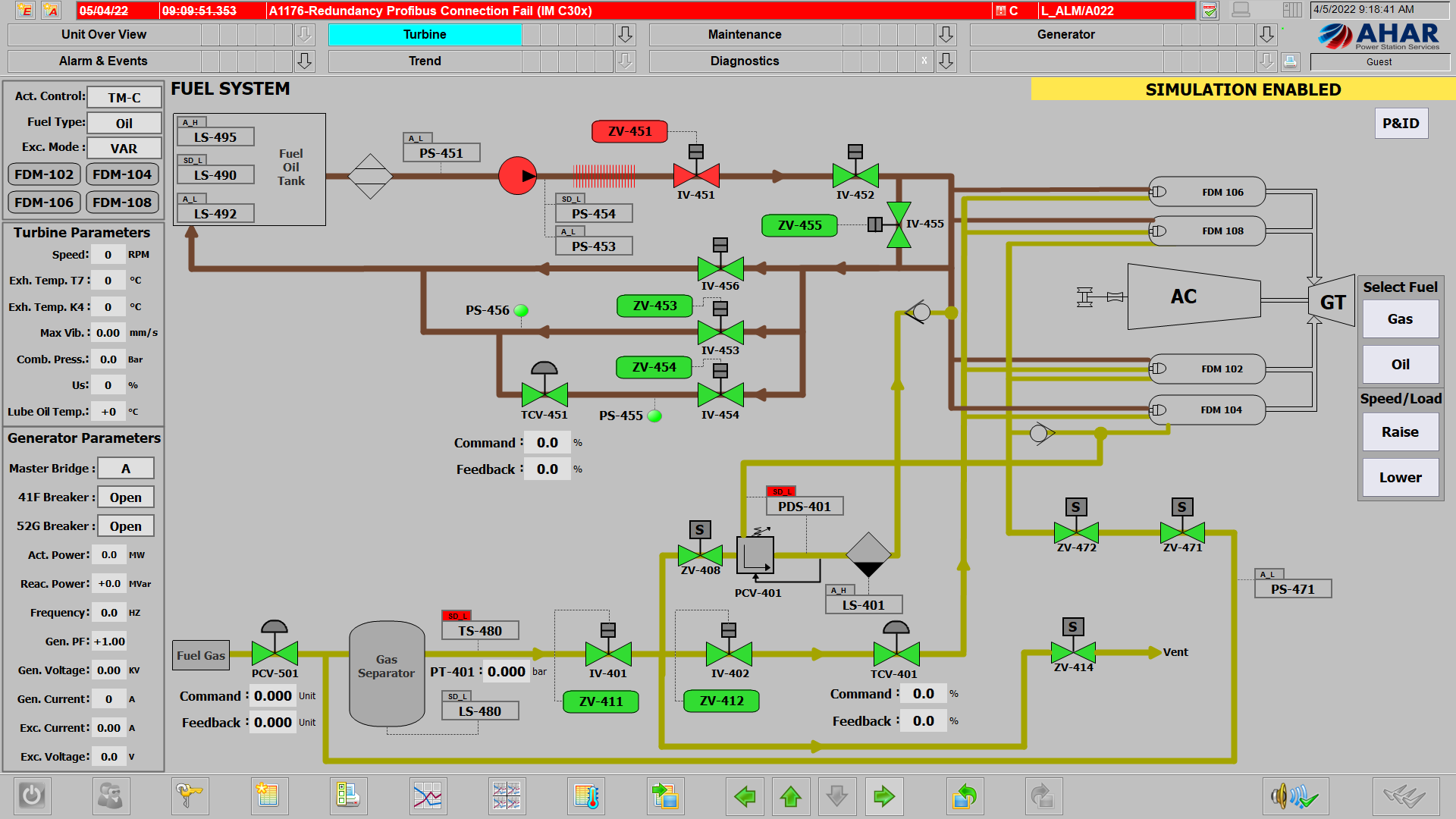
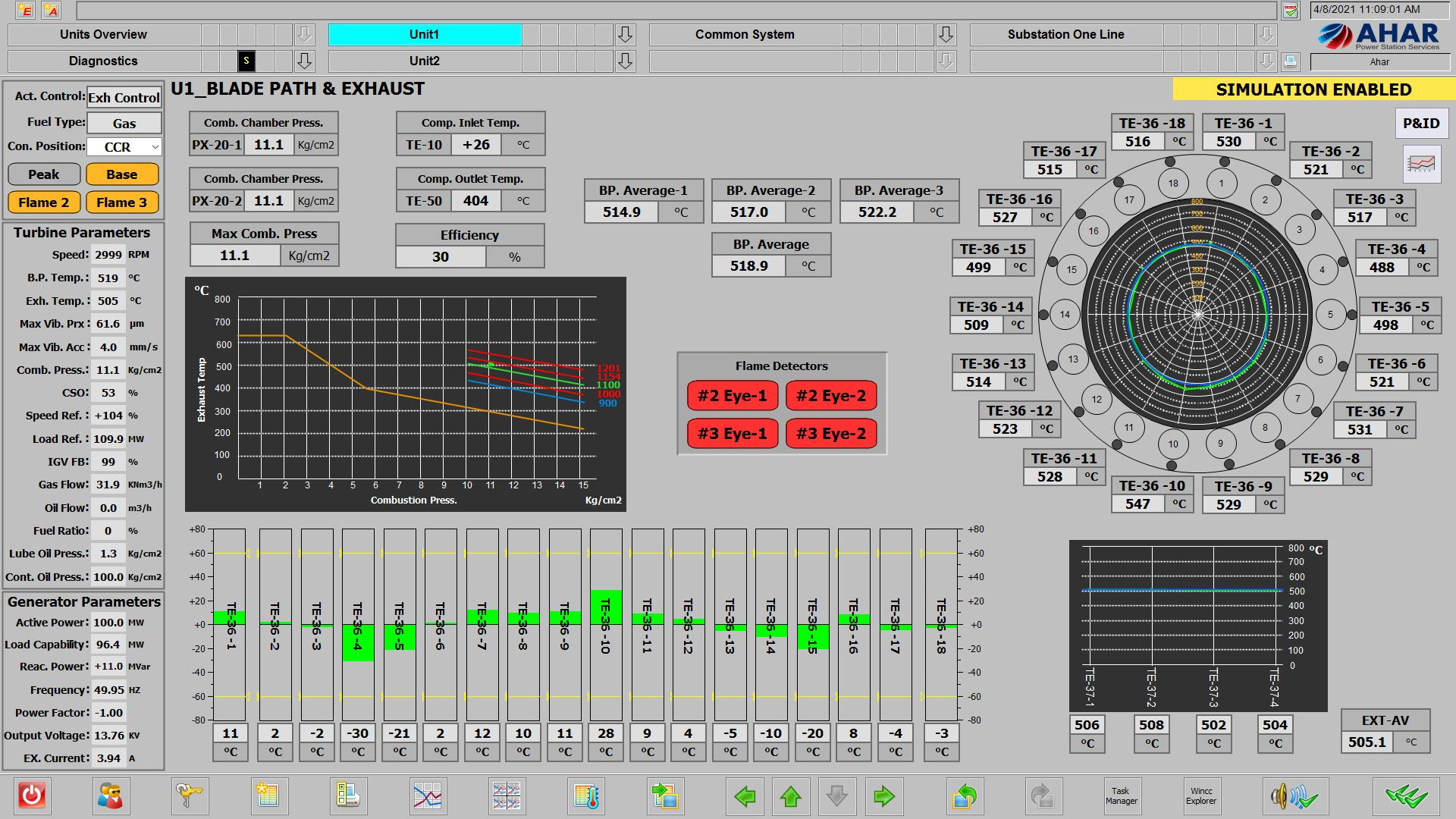
Other Features in the Configuration of the Control and Protection System
To better understand the turbine control and protection system designed by Ahar Company, a simple configuration was presented in the previous section for explanation. However, Siemens DCS also has other features that can be implemented depending on the type of project and the customer’s request. In this section of the article, we want to explain the other features that are implemented in the control and protection systems based on the following figure.
In practice, all or part of the features of the following structure may be used in different projects. Of course, Siemens DCS also has other features that are not shown in the figure below and can be implemented depending on the need.
The sentence states that before explaining the configuration, the terms “Single” and “Redundant” need to be defined. In PCS7, it is possible to use two of each device in parallel to increase reliability. If one of them fails, the other will automatically continue to operate without interrupting the system. If this feature is used, the device is said to be implemented redundantly. If there is only one of each device, it is called a single device.
Redundancy is an option and can be implemented according to the customer’s request. Redundancy can also be implemented for only a specific section. For example, only the CPU processors (S7-400) can be made redundant, or only the input and output modules. Full redundancy can also be used, and all devices can be implemented redundantly.
With this explanation, the following sections of the configuration will be explained:
Control Modules - Protection Modules Single / Redundant
The single mode of these modules is the same as what has been explained before, but in the redundant mode, 2 of each module are installed. If one of them fails, the other one continues to work.
CPU(S7-400) Single / Redundant
The processors can also be single or redundant. If the processors are implemented redundantly, they are connected to each other by an optical cable. If one of them fails, the other one will immediately take over.
Speed and Vibration Protection Systems and Peripheral Cards
If a redundant Profibus network is used, two Profibus ports must be used in this equipment. This equipment also has the ability to be redundant itself, and two sets of them can be used for more reliability.
Industrial Ethernet Single /Redundant
The network can also be defined as single or redundant for communication with the monitoring systems.
Single / Redundant Servers
In the simple structure that was explained before, a server was not used. However, in larger projects, a server is usually considered for communication between the control and protection section processors and the monitoring systems. These servers prevent a large number of monitoring systems from slowing down the communication and storage of information.
These systems can be single or redundant. If the redundant mode is used, if one of the servers fails, the other will continue to operate without interruption.
Single / Redundant Archive
In some projects, the Archive system is used to store alarms and trends of the unit. These systems have the ability to store information for many years and prevent other systems such as servers and monitoring systems from slowing down. These systems can also be implemented as Single or Redundant.
Operation System(OS)
In the simple design that was presented before, there was only one OS system. However, in practice, a large number of these systems can be implemented for different users and in different locations.
Engineering system(ES)
The Engineering system(ES) is used for troubleshooting and engineering operations with the required software. It can be used to make the desired changes to the system.
Portable Engineering system(ES)
A portable engineering system (laptop) can be considered for troubleshooting or changing programs.
Printer
This printer is used to print log sheets, trends and alarms.

Software for the Control and Protection System
The Siemens PCS7 software suite is used for the configuration and programming of the control and protection system. Some of the features of the Siemens software are as follows:
• Programming with high-level graphical tools (CFC, SFC languages, etc.) and a powerful library.
The process-specific coding is done graphically. Therefore, the process can be clearly checked. With a powerful library, various mathematical and logical functions, etc. are available to the programmer.
• Simple troubleshooting of the program with graphical paths and online.
For process troubleshooting, you can go online with the codes and check the desired path.
• Possibility of troubleshooting hardware and network problems.
In addition to coding errors, you can also track errors in devices and the network online.
The sentence also states that the software has many other features that are not listed.
The sentence concludes by stating that the PCS7 software suite is a powerful tool for the configuration and programming of the control and protection system.
Capabilities of the Ahar Turbine Control and Protection System
In the previous sections, we introduced the structure of the control and protection system built by Ahar Company. In this section of the article, we want to briefly explain the hardware and software capabilities of this system.
Ability to install on different turbines:
- Possibility of installation for all models of steam and gas turbo generators with any model and any amount of power
- Possibility of installation for turbo pumps (two-shaft turbines for pumping gas and liquids)
Hardware and software capabilities of the system:
- There is a possibility of upgrading and expanding the hardware and software. Due to the modularity of the DCS system, if after implementation, engineers want to add, for example, inputs or outputs, the related hardware and software can be easily expanded.
- Possibility of implementation with Single/Redundant model
- Possibility of implementing various monitoring systems at different points
- Fail Safe capability for protection signals
- Communication with high-level industrial Ethernet standard networks and Profibus at the lower level, which allows communication with equipment from different companies.
- Communication with management and office automation levels
- High speed for analog signals
- Ability to read pulses for accurate reading of turbine speed
- Ability to read LVDT (a type of structure that indicates the amount of valve opening)
- Ability to synchronize the processing time of different sections and also monitoring systems
- Using high-speed inputs to read logic changes
- …
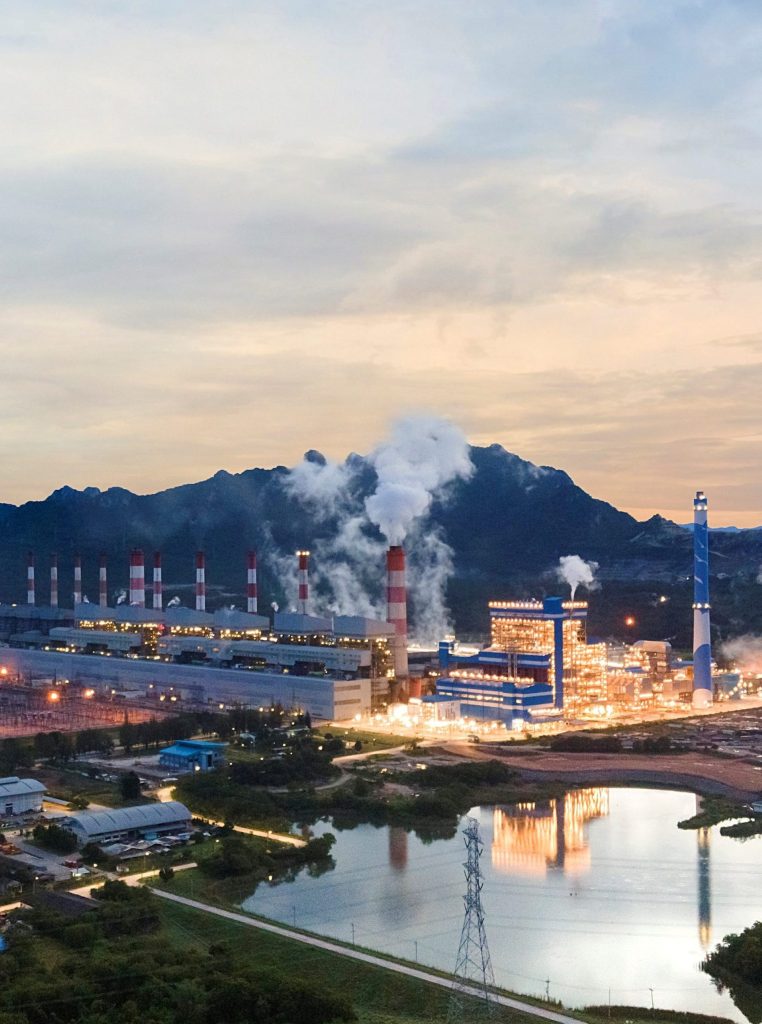
The sentence also states that the system has many other capabilities that are not listed.
The sentence concludes by stating that the Ahar Turbine Control and Protection System is a powerful and versatile system that can be used on a variety of turbines.
Code Capabilities:
- Ability to customize the codes according to the control algorithm of each turbine
- Has a defective thermocouple detection algorithm
- Has a turbine temperature calculation algorithm
- Has a turbine speed calculation algorithm
- Calculation of instantaneous efficiency and production capacity (possibility of sending to dispatching)
- …
Ability to work in the following operating modes:
- Droop mode. (Operating mode in a power grid with multiple generators)
- Isochronous mode. (Operating mode when the turbine is located on an island or in a factory and must control the frequency of the network)
- Load control mode (operating mode that produces the set load value)
